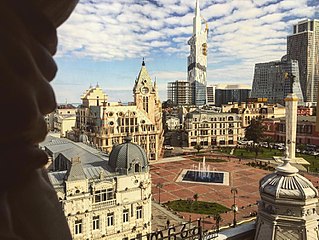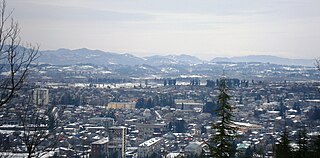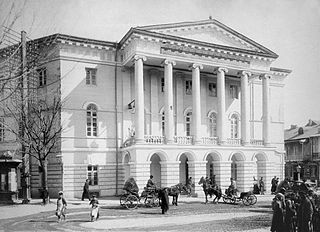
Batumi is the capital of Autonomous Republic of Adjara and the second-largest city of Georgia, located on the coast of the Black Sea in the country's southwest. It is situated in a Subtropical Zone at the foot of Caucasus. Much of Batumi's economy revolves around tourism and gambling, but the city is also an important sea port and includes industries like shipbuilding, food processing and light manufacturing. Since 2010, Batumi has been transformed by the construction of modern high-rise buildings, as well as the restoration of classical 19th-century edifices lining its historic Old Town.

Trafalgar Square is a public square in the City of Westminster, Central London, built around the area formerly known as Charing Cross. Its name commemorates the Battle of Trafalgar, a British naval victory in the Napoleonic Wars with France and Spain that took place on 21 October 1805 off the coast of Cape Trafalgar.

Oxford Street is a major road in the City of Westminster in the West End of London, running from Tottenham Court Road to Marble Arch via Oxford Circus. It is Europe's busiest shopping street, with around half a million daily visitors, and as of 2012 had approximately 300 shops. It is designated as part of the A40, a major road between London and Fishguard, though it is not signed as such, and traffic is regularly restricted to buses and taxis.

Zviad Gamsakhurdia was a Georgian politician, dissident, scholar, and writer who became the first democratically elected President of Georgia in the post-Soviet era. Gamsakhurdia is the only Georgian President to have died while formally in office.

Merab Kostava was a Georgian dissident, musician and poet; one of the leaders of the National-Liberation movement in Georgia. Along with Zviad Gamsakhurdia, he led the dissident movement in Georgia against the Soviet Union, until his death in a car accident in 1989.

The Tbilisi Metro is a rapid transit system in Tbilisi, Georgia. Opened on 11 January 1966, it was the first West Asia and fourth metro system in the former Soviet Union. Like other ex-Soviet metros, most of the stations are very deep and vividly decorated.

Rustavi is a city in the southeast of Georgia, in the province of Kvemo Kartli, situated 25 km (16 mi) southeast of the capital Tbilisi. It has a population of 125,103 and is dominated by the Rustavi Metallurgical Plant.

Ozurgeti is the capital of the western Georgian province of Guria. It was formerly known as Macharadze or Makharadze. It is a regional center of tea and hazelnut processing.

The March 1956 demonstrations in the Georgian SSR were a series of protests against Nikita Khrushchev's de-Stalinization policy, which shocked Georgian supporters of Marxist–Leninist ideology. The center of the protests was the republic's capital, Tbilisi, where spontaneous rallies to mark the third anniversary of Stalin's death and to protest Khrushchev's denunciation of Stalin quickly evolved into an uncontrollable mass demonstration and rioting which paralyzed the city. Soon, political demands such as the change of the central government in Moscow and calls for the independence of Georgia from the Soviet Union appeared.

The Mingrelians are an indigenous Kartvelian-speaking ethnic subgroup of Georgians that mostly live in Samegrelo region of Georgia. They also live in considerable numbers in Abkhazia and Tbilisi. In the pre-1930 Soviet census, the Megrelians were afforded their own ethnic group category.

Freedom Square, formerly known as Erivanor Pashkevich-Erivanskaya Square under Imperial Russia and Lenin Square under the Soviet Union, is located in the center of Tbilisi at the eastern end of Rustaveli Avenue.

The Sioni Cathedral of the Dormition is a Georgian Orthodox cathedral in Tbilisi, the capital of Georgia. Following a medieval Georgian tradition of naming churches after particular places in the Holy Land, the Sioni Cathedral bears the name of Mount Zion at Jerusalem. It is commonly known as the "Tbilisi Sioni" to distinguish it from several other churches across Georgia bearing the name Sioni.

The Holy Trinity Cathedral of Tbilisi commonly known as Sameba is the main cathedral of the Georgian Orthodox Church located in Tbilisi, the capital of Georgia. Constructed between 1995 and 2004, it is the third-tallest Eastern Orthodox cathedral in the world and one of the largest religious buildings in the world by total area. Sameba is a synthesis of traditional styles dominating the Georgian church architecture at various stages in history and has some Byzantine undertones.

The Art Museum of Georgia (AMG), alternatively known as Shalva Amiranashvili Museum of Fine Arts, is one of the leading museums in the country of Georgia. Falling under the umbrella of the Georgian National Museum, AMG is located near Freedom Square, Tbilisi and possesses around 140,000 items of Georgian, Oriental, Russian, and other European art.

Saint George's Church is a 13th-century Armenian church in the old city of Tbilisi, Georgia's capital. It is one of the two functioning Armenian churches in Tbilisi and is the cathedral of the Georgian Diocese of the Armenian Apostolic Church. It is located in the south-western corner of Vakhtang Gorgasali Square (Meidani) and is overlooked by the ruins of Narikala fortress.

Hajiqabul is a town and municipality in and the capital of Hajigabul District of Azerbaijan. It has a population of 23,512. The municipality consists of the city of Qazıməmməd and the village of Balıqçı.

The Armenians have historically been one of the main ethnic groups in the city of Tbilisi, the capital of Georgia. Armenians are the largest ethnic minority in Tbilisi at 4.8% of the population. Armenians migrated to the Georgian lands in the Middle Ages, during the Muslim rule of Armenia. They formed the single largest group of city's population in the 19th century. Official Georgian statistics of 2014 put the number of Armenians in Tbilisi 53,409 people.

Paradise, formerly named Paradise Circus, is the name given to an area of approximately 7 hectares in Birmingham city centre between Chamberlain and Centenary Squares. The area has been part of the civic centre of Birmingham, England since the 19th century when it contained buildings such as the Town Hall, Mason Science College, Birmingham and Midland Institute buildings and Central Library. The site was redeveloped from 1960 to 1975 into the present Paradise Circus based within a roundabout on the Inner Ring Road system containing a new Central Library and School of Music. From 2015 Argent Group will redevelop the area into new mixed use buildings and public squares.

























